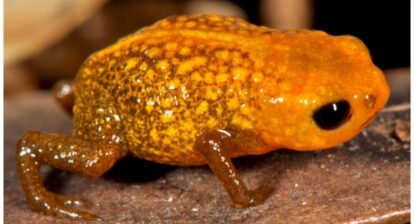In this video a male orb-weaving spider Philoponella prominens (Uloboridae) catupults away to avoid being eaten by its mate – and it is the coolest thing ever!
In the animal kingdom, especially amongst insects and arachnids, many males beat a hasty retreat after copulation with the female because chances are that once she has had her way, she will end the date with a nice meal – and eat him. Male spiders especially have to do this amongst quite a few species. If they succeed in running away, they can live to copulate (and die) another day.
Animals also utilize various mechanisms to allow for very fast catapult-like mechanisms that help them to escape predators, or to catch prey. But such behaviour was not previously seen to escape sexual cannibalism. Researchers studying spider mating in the lap noted that out of 155 successful matings, only three did not manage to catapult away (and were summarily eaten).
They say in the study, “In the animal world, numerous mechanisms have been described that allow for extremely fast actions or reactions via the slow storage of energy, typically in elastic structures, which is then nearly instantly released, similar to the operation of a catapult. Many of these mechanisms are employed for prey capture or for predator avoidance; however, such superfast actions have not yet been reported as a means to dodge sexual cannibalism.”

Male and female orb-weaving spiders copulating, with the smaller male on top. Credit Shichang Zhang et al
Such action has never been observed before in spiders according to the researchers, “Here, we unveil a novel mechanism in a communal orb-weaving spider Philoponella prominens (Uloboridae), whereby males undertake a split-second catapult action immediately after mating, thereby fleeing their partner.”
When the researchers intervened by stopping 30 of the spiders from jumping away by “putting a fine brush behind their dorsum (∼2 mm) during mating”, they also did not catapult away and were eaten.
“These results clearly indicate that the catapulting behavior is an obligatory component of the male mating repertoire and a strategy to avoid the females’ attempts at post-mating sexual cannibalism”, write the scientists.
How did they manage to do this? According to the study, “males achieve their superfast action (up to 88.2 cm/s) by extending the tibia–metatarsus joint of their first leg pair via hydraulic pressure in a joint that is known to lack extensor muscles in spiders. This rapid expansion greatly reduces the likelihood of the male being sexually cannibalized”.
They basically kick the female away and throw themselves into the air at high speeds of upto 88.2 cm/s and spinning around 174 times with a maximum recorded rate of 469.2 rev/s.

Catapulting behavior of male Philoponella prominens spider.. Credit: Shichang Zhang
Jumping spiders also run away from cannibalistic mates by extending their fourth pair of legs and then jumping away. But the orb-weaving spider action is unlike that of jumping spiders.
Male orb weaving spiders may mate up to six times with the same female using this novel method to escape via silk safety lines each time. They then climb back up to copulate again. As the researchers conclude, “Males with a superior locomotory performance and a physical capacity may be able to perform the rapid catapulting behavior multiple times, thereby increasing their chance of paternity. This creates the stage for antagonistic coevolution where females can afford high levels of sexual cannibalism while not jeopardizing their mating opportunities, and males evolve behaviors, such as the rapid catapult on safety lines, to counter the effects of sexual cannibalism. We therefore conclude that the catapulting behavior is a direct adaptation to female cannibalism in P. prominens, resulting from sexual conflict.”

